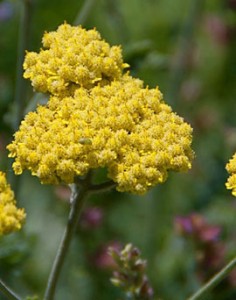Scientific Name: Achillea
Plant Family: Asteraceae
Common Name: Yarrow
Text and Photos by Janice Tucker

Western yarrow (Achillea millefolim var. lanulosa) photo: Janice Tucker
What would Achilles have done without yarrow? According to Greek mythology, this great warrior of the Trojan wars carried yarrow into battle to staunch the bleeding of his wounded soldiers, hence the genus Achillea. Mythologists claim that Achilles learned about the medicinal properties of this plant from his teacher, Chiron the Centaur. Ancients called it Herba militaris (the military herb). Not surprisingly, in the language of flowers yarrow means war or healing and the definition of Achillea is “yarrow.”
Most of the more than 85 Achillea species are native to Eurasia but there are some species considered to be native to North America. Among the Achillea species listed as native to New Mexico in Kelly Allred’s Index of New Mexico Plant Names is the Achillea millefolium, var. lanulosa or its synonym A. millefolium, var. occidentalis, commonly known as Western yarrow, which can be found at Santa Fe Botanical Garden’s Leonora Curtin Wetland Preserve.
Yarrow is a perennial, growing between one and two feet tall. Spreading rhizomes send up hairy, branched, fibrous stems lined with feathery, fern-like, alternate, dark-green leaves. In June through September, white umbel-shaped flowers appear at the ends of the stems. The flat-topped clusters of disk flowers surrounded by five petals are usually white but sometimes appear in a very pale pink shade. The entire plant exudes a spicy scent. Because it spreads from both rhizomes and seed, native yarrows can become invasive – especially in the home garden. However, some gardeners allow it to grow as a ground cover to form a tough, drought tolerant lawn by keeping it mowed. While yarrows thrive very well in dry conditions, the Western yarrow at the Leonora Curtin Wetland Preserve also seems to be right at home among the cattails and watercress near the streambed.

Western yarrow (Achillea millefolim var. lanulosa) photo: Janice Tucker
Flower colors of the numerous yarrow cultivars range from bright yellow to pink to red. The brilliant yellow Achillea x ‘Moonshine’ is one of the most popular of the cultivars and is included in the plant collection to be installed at the future Santa Fe Botanical Garden at Museum Hill. The cultivars are not usually as invasive as the native yarrows and tend to remain within their boundaries once planted in a flowerbed. Yarrow is drought tolerant, prefers full sun and well-drained soil. Infrequent watering is all that is required once the plant is established. Deadheading spent flowers will foster longer blooming seasons. Yarrows add interest to fresh or dried floral arrangements.
Millefolium is defined as many-leaved, and lanulosa means woolly, describing the small hairs on the plant. Occidentalis is another word for western, referring to countries other than the Far East, particularly Europe and the Americas. The word “yarrow” is said to have evolved from the Anglo-Saxon gearwe and the Dutch yerw.

Moonshine yarrow (Achillea x Moonshine) photo: Janice Tucket
There are many common names for this plant but it is usually called Yarrow. Spanish-Americans called it Plumijillo, translated into English as “little feather” which describes its feather-like foliage. The intriguing common names for yarrow such as Devil’s nettle, Devil’s plaything and Bad man’s plaything stem from an old superstition that Satan used to walk the streets at night and shake yarrow at homes of those he wished to curse. Its many medicinal uses include stopping bleeding, treating colds, promoting sweating and preventing baldness – just to name a few. It has even been used as a love potion and as a divining device to reveal the identity of one’s future love interest. The eighteenth century Swedish botanist, Carl Linnaeus – who first formulated the plant classification system still in use today -assigned the scientific name to the known Yarrow species at that time. However, he often referred to it by the Swedish common name of Field Hop. Field Hop was used in the manufacture of beer. Linnaeus preferred beer made with yarrow instead of hops and believed the yarrow made the brew more intoxicating.
Knowing a plant’s history certainly makes it loom larger in a garden or natural setting. Really, it’s quite wonderful to know the Yarrow species or cultivar growing in your garden is a descendant from a plant that impressed Carl Linnaeus and one that also played a role in Greek mythology, associated with the likes of the great Achilles for whom it is named. Makes it more than just a pretty flower, doesn’t it?


